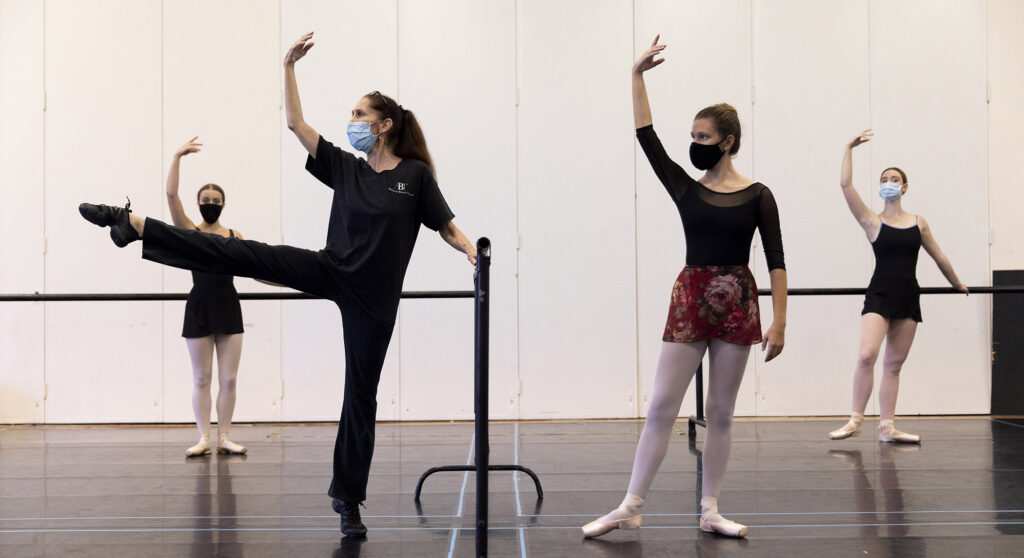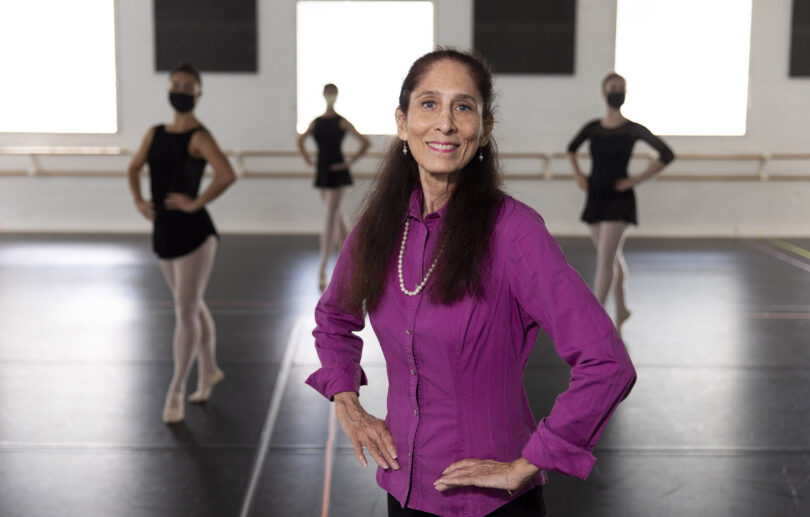Lisa Fusillo, professor of dance in the Franklin College of Arts and Sciences, says seeing students thrive and excel, and witnessing their successes as artists and as individuals, is her greatest joy.
When did you come to UGA and what brought you here?
I came to UGA in 2004, moving to the South from the long cold winters in the Midwest. When I applied for the position at UGA, I was looking for new opportunities and experiences in my academic career. While on campus for my interview, I was struck by the kindness of the people I met and was impressed with the exciting activities going on all over campus. And I was thrilled to find that the dance department had its own building!
What are your favorite courses and why?
My favorite courses are dance history, ballet technique, pointe and First-Year Odyssey seminars. These topics encompass everything that I love to teach! My teaching is greatly informed by my professional experience and training in classical ballet, so the ballet and pointe courses are an opportunity for me to share my passion, embodied knowledge and artistry. From enthusiastic beginners to experienced dancers, I am always excited to watch dance students grow and progress in their technique training, as well as in their understanding of dance, and in the self-confidence and self-awareness that a dance experience can provide.
While the dance studio is the center of art training and art making, dance history is my second passion. For me, the examination of dance history and theory goes hand-in-hand with the creative practice. I work hard to find new ways to challenge and invigorate students in dance history studies, including employing new teaching practices such as Reacting to the Past. Through involving students in my own research projects, I hope to entice them to become as excited about dance history as I am and to encourage their own journeys in research exploration.
I also love teaching the First-Year Odyssey seminars and getting to know and help guide new first-year students outside of my discipline. I have created new FYO courses every year and use that opportunity to focus on one particular topic that is often directly related to my current research project. It is so rewarding to have students from previous FYO classes come back and talk about how that one seminar had an impact on their experience at UGA.
How do you describe the scope and impact of your research or scholarship to people outside of your field?
As a dance artist and scholar, my research endeavors are both creative and scholarly. My creative work is focused on choreography, investigating creative invention in movement. I explore physical movement based in a classical ballet foundation, sometimes with contemporary and jazz influences. I am often asked about the inspiration for my choreography, and my answer is that each work/piece is different. Every choreographic work was created for a different reason, such as an exploration of complex rhythmic/music structures, a social commentary, an emotional response to loss, telling/enacting a story, an inspiration from a particular piece of music or composer, or sometimes just for the joy of dancing. My work is an expression of my ideas through movement, and I don’t expect my audience to feel that they have to understand what the piece is about. Rather, my intent is for the audience to find their own interpretation when watching the dance; perhaps they might relate to something in the movement, music or story—or perhaps they will just simply enjoy the dancing.
The scope of my scholarly work covers a broad range of topics in dance history, with a particular interest in the Ballets Russes, a dance company from the early 1900s.
I also have done significant research on a few influential modern dance artists and on the history of American musical theatre. The bulk of my research, however, is focused on the iconic ballets created by the Ballets Russes choreographer Léonide Massine, whose choreography changed the norms for classical ballet and firmly established the foundation for non-traditional contemporary ballet. (If you’ve ever seen the film “The Red Shoes,” Massine danced the role of the cobbler.) In the course of my research study, I have been very fortunate to uncover information about Massine’s ballets that had never been examined, written about or published. It is so exciting to discover this “new” information, especially considering that these ballets have been reviewed, written about and performed for a hundred years! My published work will fill some of the gaps in dance literature and will contribute to more complete documentation of this era in dance history.

From left, undergraduate Vivian Munce watches on as professor Lisa Fusillo teaches her and fellow undergraduates Avery Scott and Erin O’Keefe during a pointe class at the Dance Building. (Photo by Andrew Davis Tucker/UGA)
The one UGA experience I will always remember will be …
Selecting one experience is difficult, as my time at UGA has been rich and rewarding, with many wonderful students and experiences. Seeing students thrive and excel, and witnessing their successes as artists and as individuals, is my greatest joy. Several years ago, I created a project to bring Diavolo Dance Theatre to UGA, specifically to provide a performance experience for our students, as well as a public performance by the company. It was a very exciting project, but also risky as it was a costly endeavor and at that time; the Diavolo was not well-known on the “east coast.” The project included 18 theatre and dance students who worked with the Diavolo company for a week, learning the choreography with the dedication and passion of young professionals. At the end of the week, the students performed with the Diavolo company in the newly renovated UGA Fine Arts Theatre. The students were brilliant in a breath-taking performance. They exuded confidence, talent, and professionalism, and stood very proudly with the company members on stage. At the end of the evening when all the performers took a bow together in front of the sold-out theatre, the Diavolo company members stepped back and applauded the student performers; bursting with pride, the entire audience erupted in an ecstatic standing ovation for these young performers. It was truly extraordinary.
One other UGA memory that will stay with me is when my students demonstrated, without hesitation or coaching, the finest qualities of respect and compassion during the first dance study abroad in Costa Rica. There were six dance students among about 200 students staying at the UGA campus. One night in the cantina (dining hall), when the kitchen staff had all gone home ill, my students stepped in to take care of the cleanup after the dinner service. Without saying a word, when they saw the manager struggling alone in the kitchen, they walked in and took over the kitchen. They escorted me out and began singing and dancing while they scrubbed the dishes, cleaned the floors and tables, and finished the work that had to be done. The manager, overcome with gratitude, cried as he thanked the students. The next morning at breakfast, the Costa Rican workers were all talking about “las bailarinas.” It was a small act of kindness that had an important impact on the local workers, who felt respected for the service that they provided day after day. Colleagues have told me that the story of “las bailarinas” dancing in the kitchen continued to be told for several years afterward.
I am still so very, very proud of those young students for being wonderful, caring and respectful individuals.
And I will always remember teaching with the UGA at Oxford program. What a glorious opportunity! It was a most extraordinary and wonderful experience, for which I will always be grateful—a great highlight in my academic career!







